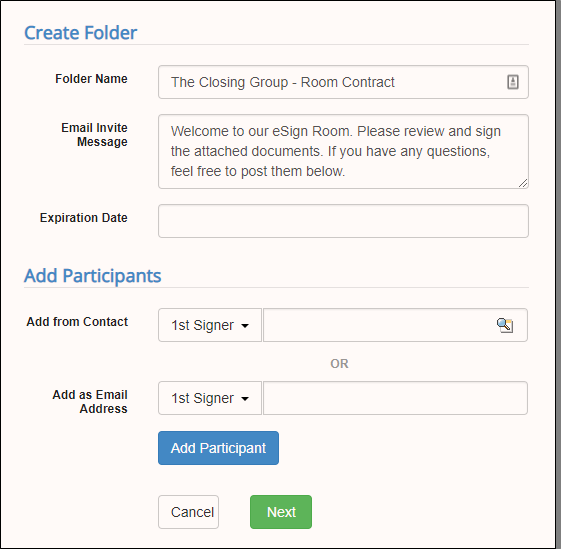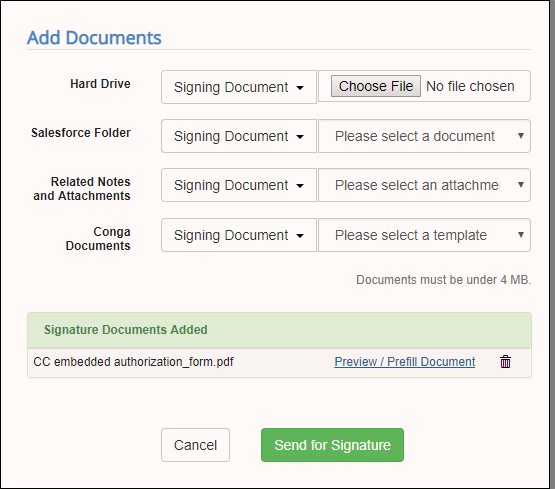Sending Documents in Salesforce Classic
After you complete your installation and configuration of Sertifi for Salesforce Classic, you can send documents to your clients. When you send out a document via Sertifi for Salesforce, you send the document in what's known as a Folder. A folder contains the signature document, reference documents, and any payments added to the contract as well.
To send a folder in Salesforce Classic:
Click the Sertifi E-Sign button from the Salesforce object on which you configured Sertifi (typically the Opportunity object). The Sertifi Sending Wizard opens.
Enter the following fields:
Folder Name - enter a name for the folder that will contain your signature and/or reference documents.
Note
The folder name will also be used as the subject lines for the email that will be sent to your clients, so be sure it's descriptive and appropriate. Sertifi recommends using a naming convention so that your folders are easy to search and identify.
Email Invite Message - the message you want your signers to see in the email they receive notifying them of the document.
Expiration Date - the date when you want the document to expire. Select a date from the date picker.
Select how you want to add participants. Participants are the individuals or companies that are going to sign your document. You have two methods for adding participants:
Click Add from Contact, click
 and then select a participant from your Salesforce address book
and then select a participant from your Salesforce address bookClick Add as Email Address to enter the email address of your participant that's not currently in your Salesforce address book.
Click Add Participant.

Optional – Select the next level signer level (from 2 –10) from the dropdown, and enter in all the participants you need. You can add multiple participants at each signer level; for example, if you need two first-level signers, you can add them both as 1st-level signers.
Caution
If you add multiple signer levels to your folder, note that each group after the 1st level can't sign the document until the signers before them complete the signature process. For example, a second signer can't sign a document until all 1st-level signers sign and submit the document.
Optional – Select Carbon Copy from the dropdown to add a Carbon Copy recipient to the file.
Click Next. The Add Documents and Add Payments page will appear.
Select from the following locations to add your signature document:
Hard Drive - browse on your machine to locate the signature document.
Salesforce Folder - select a document from your preexisting Salesforce folders.
Related Notes and Attachments - select a signing or reference document to provide more information to your signers.

Optional - Preview or Prefill your document. For more information, reference the Document Editor guide.
Optional - Add a Payment if you're using Sertifi ePayments, or an Authorization if you're using Sertifi eAuthorizations, by completing the following fields:
Description - add a title for the payment. This name is viewable by your clients.
Type - select Payment or Authorization.
Amount - enter the amount of the payment.
Date Due - enter the date the payment is due.
Click Add Payment.
Optional – Repeat steps 10-11 to create multiple payments.
Click Send for Signature. Your document is sent to your signers for signature.
Once your signer receives your signature document and signs it, the Sertifi E-Contact tab updates with the following information:
File name – the name of folder you created.
Created date – the date the request was created.
Open – the number file rooms open with a document sent to a client.
Partially Signed – the number of documents partially signed.
Signed – the number of documents completely signed.
Unpaid –the number of unpaid payments for the booking.
Paid – the number of payments paid for the booking.
Authorized – the number of payments authorized for the booking. This column appears when you send a payment authorization.